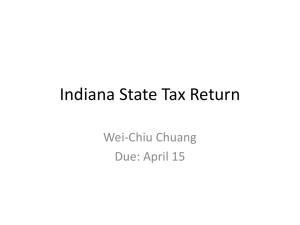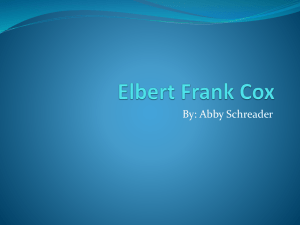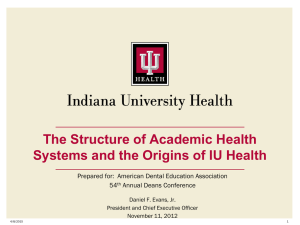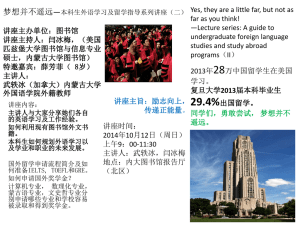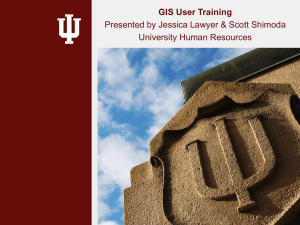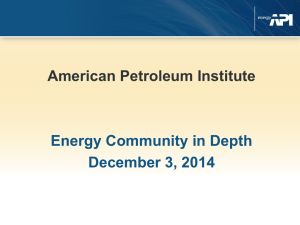TransPAC Update August, 2014, TEIN Talk
advertisement
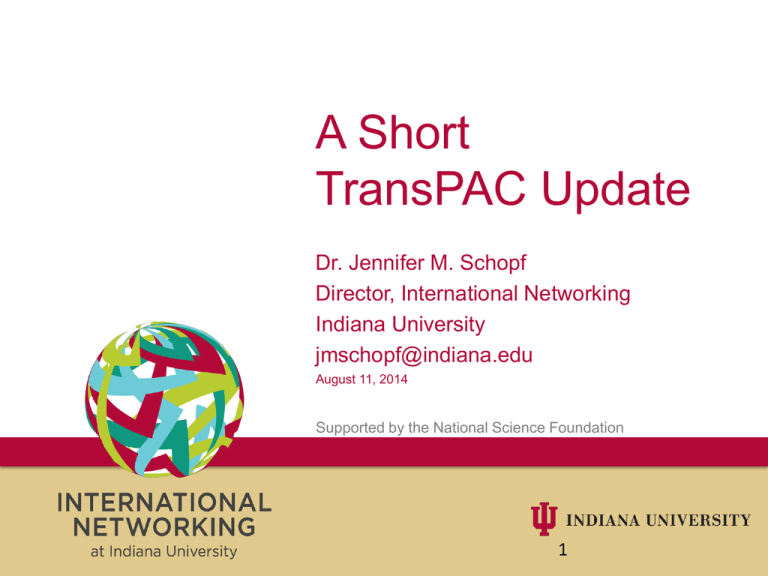
A Short TransPAC Update Dr. Jennifer M. Schopf Director, International Networking Indiana University jmschopf@indiana.edu August 11, 2014 Supported by the National Science Foundation 1 Introduction • IU currently has two international networking projects – Funded by the US National Science Foundation – Part of the International Research Network Connections (IRNC) Program • America Connects to Europe (ACE) • TransPAC, focuses on Asia • http://internationalnetworking.indiana.edu/ 2 TransPAC Today • 15+ year history • Cooperative partnership among Indiana University, APAN, TEIN*CC, NICT-Japan, NII-Japan, CERNET, and others • 30Gbps deployed between US and Asia – 10Gbps LA-Tokyo funded by NSF – 10Gbps Tokyo-LA funded by NICT – 10Gbps LA-Beijing funded by CERNET+NSF 3 4 Current TransPAC Projects • • • • Deployment of measurement tools Deployment of dynamic circuit services Development of SDN (OpenFlow) services Support for application end-users • In Year 5 of 5 year award – Runs through May 2015 5 We have applied for • TransPAC4: Pragmatic Application-Driven International Networking • To run Jan 2015-Dec 2019 • New project requests $1.2M/year for 5 years • Includes funding for circuits, exchange points, application support, research 6 System Design • Built-in redundancy and alternative paths • Easy transition from the current TransPAC3 circuits • Complementary paths and approaches to our partners’ sister circuits • Full support of production traffic, through reliable technology choices and capacity matching current and growing needs • Ongoing support for experimental traffic • Fiscally responsible approaches 7 TransPac4 Phase 1 (2015-2016) 8 TransPAC4 Phase 2 (2017-2019) 9 Why not 100G in Year 1 (2015)? • Price tag: $2-3M per year, just for the circuit • A year of the ANA-100G link has shown that the technology may not be fully stable yet • Current Asian inter-country connectivity not yet 100G in many cases • Few applications require more than 10G flows right now • Few exchange points are ready for this now 10 Details • Transport: Support for Layer 3 peering as well as multiple mechanisms for dynamic Layer 2 circuits • Experimental work with SDN, FlowVisor, InterDomain Controllers, Path Hinting, WAN acceleration 11 End User Engagement • Directly engage with user communities • Focusing on end-to-end performance • Application Advocacy Specialists will work closely with end users with network needs – including US branch campuses in Asia • Potential to be transformational to international science 12 IRNC Other • Solicitation – http://www.nsf.gov/pubs/2014/nsf14554/nsf14554.htm • Indiana University submitted 2 other proposals to the IRNC program – NetSage: Measurement of international links • IU, U Hawaii, UC Davis/ESNet – International Network Operations • Waiting on notification – hopefully this fall 13 Introducing Joe Lappa 14 Some meetings to think about • PRAGMA 27 – October 15-17, 2014, Indiana Univ. Bloomington – http://www.pragma-grid.net/workshops.php • GENI Engineering Conference 21 – October 20-23, 2014, Indiana Univ. Bloomington – http://groups.geni.net/geni/wiki/GEC21Agenda • I2/ESnet Tech Exchange – October 26–30, 2014, Indianapolis, IN – http://www.internet2.edu/newsevents/events/technology-exchange/ 15 Questions/Comments? • Group Website: http://internationalnetworking.indiana.edu/ • Me: Jennifer Schopf – jmschopf@indiana.edu • Are you trying to transfer data to the US? – Please let us know! – We have resources to help you 16

